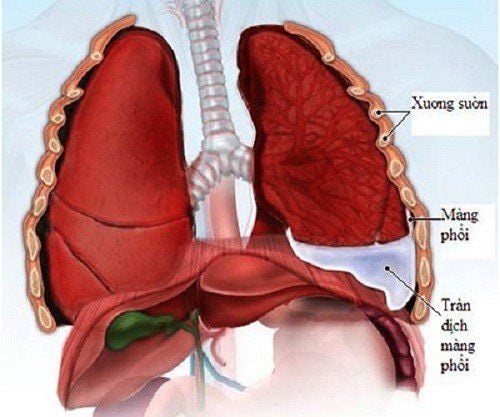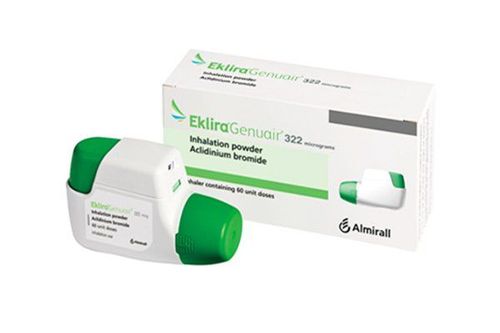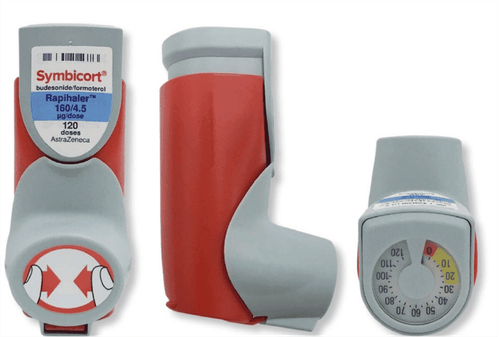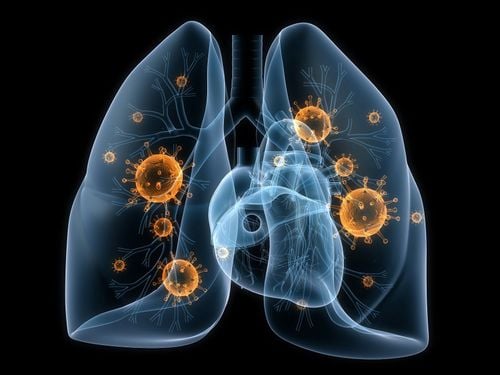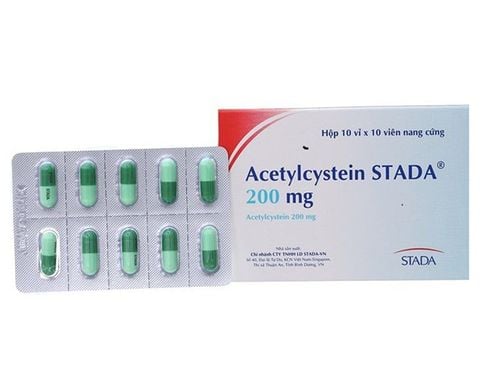This is an automatically translated article.
The article was written by Doctor Luong Vo Quang Dang, Internal Cardiologist - Head of Internal Medicine Department, Vinmec Phu Quoc International General HospitalChronic Obstructive Pulmonary Disease (COPD) is a smoking-related chronic respiratory disease that represents a significant economic burden on the global healthcare system. COPD affects both developed and developing countries. In 2010, the number of COPD cases worldwide was about 384 million, equivalent to a prevalence of 11.7%. COPD is predicted to become the 3rd leading cause of death by 2020.
1. What is COPD?
Chronic Obstructive Pulmonary Disease (COPD) stands for Chronic Obstructive Pulmonary Disease. In which: Lung disease is a medical condition with damage to lung parenchyma and airways; Obstruction is airflow in and out of the lungs that is obstructed or partially blocked; Chronic is persistent, prolonged, irreversible and leaves many sequelae.Chronic obstructive pulmonary disease is a preventable disease. COPD is a consequence of lung damage caused by frequent and long-term exposure to toxic substances such as: cigarette smoke, polluted air, charcoal smoke..., most commonly cigarette smoke. Early avoidance of exposure, or cessation of smoking altogether, is of great significance in the prevention or treatment of COPD.
2. Is COPD a common disease?
With smoking habits still widespread, the prevalence of COPD is increasing, and the burden of disease due to COPD is increasing in Vietnam. On average, 12 out of every 100 people have COPD. COPD is mainly seen in people over 40 years of age. But in fact, lung damage appeared and progressed gradually from the 20s, when they started smoking their first cigarettes. Therefore, COPD is more common in men than in women, because smoking habits are more common in men.
3. What are the symptoms of COPD?
If the typical 4 symptoms of Asthma are cough, shortness of breath, wheezing and chest tightness, then COPD also has similar symptoms, but with differences in nature, as follows:3.1. Cough Cough is usually the first manifestation, with or without sputum production. The initial cough may be transient, recurring, and gradually become more frequent. Patients often blame this cough symptom on smoking, and do not need to seek medical attention or treatment. But when the next symptom comes up that makes them really worried, it's shortness of breath.
3.2. Shortness of breath and wheezing Shortness of breath and wheezing occur with exertion, such as when walking up stairs. Difficulty breathing will increase gradually, quickly or slowly depending on whether the patient continues to smoke or not. Heavy or strenuous activities are affected first. Next, daily activities such as bathing, walking will be restricted. Even in the final stage, the patient can only sit and focus on breathing. Shortness of breath that limits movement is often a reason to seek medical attention.
3.3. Sputum production Sputum production is often accompanied by a cough. Sputum represents inflammation caused by chronic damage to the airways. Sputum may be clear or opaque, white or yellow or green. A change in sputum color and an increase in the amount of sputum produced each day can signal an impending COPD exacerbation. During an acute exacerbation of COPD, all of the above symptoms are more prominent, more severe. Examples include severe shortness of breath and wheezing, chest tightness, markedly reduced exercise capacity, more frequent coughs with increased sputum volume, and discolored sputum. The most common cause of COPD exacerbations is a viral or bacterial infection.
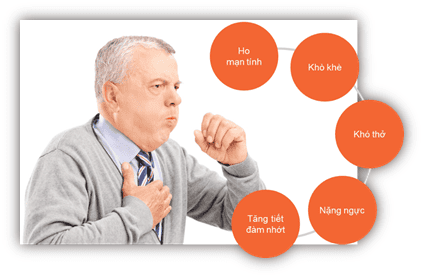
4. What causes COPD?
Smoking is the main cause of chronic damage in the lungs and airways, which can progress to COPD over the years. These lesions result from prolonged inflammation on the airway surfaces, triggering a cough reflex, increasing sputum production, and gradually causing destruction of the elastic structures in the lung parenchyma.Smoking occurs mainly in men. Women can also develop COPD by the same mechanism as above. But through:
Passive smoking : People exposed to secondhand smoke, such as wives and children whose husbands/fathers smoke in the home. The harm of secondhand smoke is 90% equivalent to that of a real smoker. People who cook coal/firewood in the kitchen : Smoke generated from burning coal/firewood (biomass fuel) also causes damage to the lungs and airways similar to cigarette smoke. People exposed to incense smoke: Regular and dense exposure to incense smoke, such as monks in communal houses/temples/temples, also causes damage to the lungs and airways similar to cigarette smoke. Air pollution: Besides, air pollution also contributes to COPD, or aggravates existing COPD. Indoor air pollution such as dust, soot (fireplace), chemical dust, mold...; Air pollution outside the home such as smoke from vehicles, waste... Air pollution combined with smoking increases the likelihood of COPD.
5. Is COPD an Asthma?
COPD and Asthma are two completely different diseases, although both are diseases of the lungs and airways and have common symptoms of shortness of breath and wheezing. The following few features help distinguish these two conditions:In COPD, damage to the lungs and airways is irreversible. Airway narrowing and persistent (chronic) symptoms. Therapeutic drugs also do not help much in opening the airways back. In Asthma, the airways narrow as a result of the surrounding smooth muscles constricting under the stimulus of acute inflammation. This phenomenon is transient, recurrent and can be completely reversible spontaneously or under the influence of therapeutic drugs. In COPD, besides shortness of breath, there are symptoms of chronic cough and sputum production. In Asthma, wheezing, paroxysmal nocturnal dyspnea are common. COPD does not. COPD usually begins after age 40. While Asthma, is common under 35 years old, and can also develop from very early infancy (under 1 year old). Asthma patients often have additional allergic conditions such as allergic rhinitis, eczema, and drug or food allergies. Some patients have both Asthma and COPD, now known as “Asthma COPD Overlap” (ACO). More information about Asthma and ACO please read in the following articles.
6. How is COPD diagnosed?
Clinicians will rely on the following clinical information:Nature of dyspnea, wheezing, and other accompanying symptoms. Degree of impact of exercise History of smoking, occupational exposure to dust... History of cardiovascular disease, asthma, allergies, other co-morbidities. On physical examination, some signs suggestive of COPD include:
Snoring or hissing sound when the doctor listens with a stethoscope: due to the airflow having to go through the narrowed airways. The “barrel chest” and “dilated intercostal spaces” occur when the lungs are over-inflated because inhaled air is “contained” in the lungs. The pursed-lip exhalation is a way that people with COPD are taught or found on their own to make breathing easier. Pulmonary function test (Sspirometry):
Is the most reliable and common test to diagnose COPD. The patient needs to take a deep breath and blow hard into a device connected to a computer that can measure the indicators of air flow in and out of the lungs, thereby calculating how well the patient's lung function is working. The patient may be asked to take an inhaler to optimize lung function, and then a second spirometry test. This is called a bronchodilator test. The difference between the results of spirometry before and after the bronchodilator test provides a lot of information to help diagnose the disease. In addition to the purpose of diagnosing COPD, spirometry results also help to classify the severity of COPD, thereby guiding the selection of appropriate treatment. Every 3 to 6 months, patients with COPD should have their spirometry rechecked to assess response to treatment and rate of disease progression.

7. How severe is COPD?
As described above, lung lesions in COPD are irreversible with progressive deterioration. The lung function of people with COPD will decline over time at a faster rate than the general population. They will find it difficult to breathe, feel less air in and out of their lungs, causing many limitations in lifeand activities.
Besides, people with COPD very often experience sudden episodes of severe shortness of breath that require hospitalization. These are called acute exacerbations of COPD. At that time, the patient's lung function will decrease rapidly, the treatment process will be difficult and prolonged. The more severe the COPD, the greater the frequency of exacerbations. Exacerbations are the cause of death in the majority of patients with COPD. By 2020, COPD is estimated to be the third leading cause of death, after cardiovascular disease and stroke.
Another factor, COPD occurring in the elderly will lead to the presence of a series of other accompanying diseases, called co-morbidities, such as: Cardiovascular disease, diabetes, cancer, osteoporosis , depression, sleep apnea... This increases the burden of symptoms on patients, increases the cost of treatment and care, and increases mortality in patients with COPD.
8. Where can I get a diagnosis of COPD?
Currently, Vinmec Phu Quoc International General Hospital provides spirometry services and in-depth examination of COPD pathology. With the careful examination and consultation of respiratory specialists, spirometry techniques performed by well-trained nurses, the hospital will help patients get early diagnosis, effective treatment. High efficiency, few side effects and lower treatment costs.Please dial HOTLINE for more information or register for an appointment HERE. Download MyVinmec app to make appointments faster and to manage your bookings easily.





